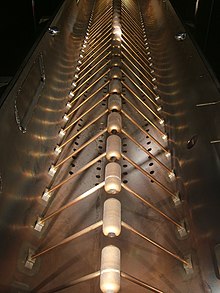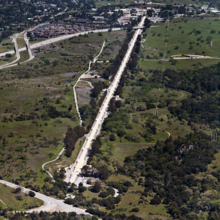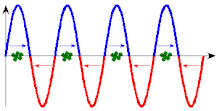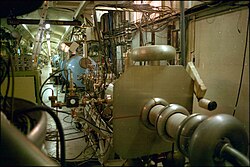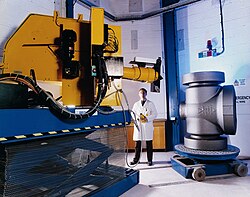
A cyclotron is a type of particle accelerator invented by Ernest Lawrence in 1929–1930 at the University of California, Berkeley, and patented in 1932. A cyclotron accelerates charged particles outwards from the center of a flat cylindrical vacuum chamber along a spiral path. The particles are held to a spiral trajectory by a static magnetic field and accelerated by a rapidly varying electric field. Lawrence was awarded the 1939 Nobel Prize in Physics for this invention.

Fermi National Accelerator Laboratory (Fermilab), located in Batavia, Illinois, near Chicago, is a United States Department of Energy national laboratory specializing in high-energy particle physics.

The Tevatron was a circular particle accelerator in the United States, at the Fermi National Accelerator Laboratory, east of Batavia, Illinois, and was the highest energy particle collider until the Large Hadron Collider (LHC) of the European Organization for Nuclear Research (CERN) was built near Geneva, Switzerland. The Tevatron was a synchrotron that accelerated protons and antiprotons in a 6.28 km (3.90 mi) circumference ring to energies of up to 1 TeV, hence its name. The Tevatron was completed in 1983 at a cost of $120 million and significant upgrade investments were made during its active years of 1983–2011.
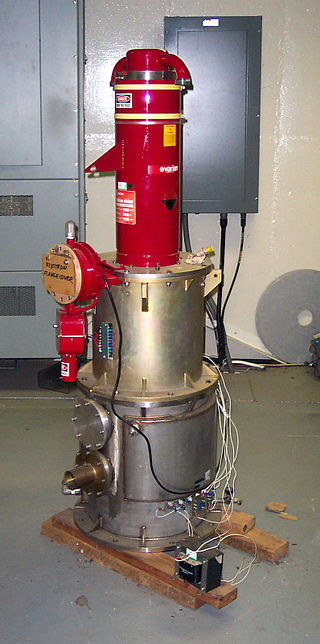
A klystron is a specialized linear-beam vacuum tube, invented in 1937 by American electrical engineers Russell and Sigurd Varian, which is used as an amplifier for high radio frequencies, from UHF up into the microwave range. Low-power klystrons are used as oscillators in terrestrial microwave relay communications links, while high-power klystrons are used as output tubes in UHF television transmitters, satellite communication, radar transmitters, and to generate the drive power for modern particle accelerators.
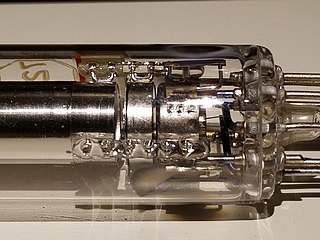
An electron gun is an electrical component in some vacuum tubes that produces a narrow, collimated electron beam that has a precise kinetic energy.

A synchrocyclotron is a special type of cyclotron, patented by Edwin McMillan in 1952, in which the frequency of the driving RF electric field is varied to compensate for relativistic effects as the particles' velocity begins to approach the speed of light. This is in contrast to the classical cyclotron, where this frequency is constant.

A synchrotron is a particular type of cyclic particle accelerator, descended from the cyclotron, in which the accelerating particle beam travels around a fixed closed-loop path. The magnetic field which bends the particle beam into its closed path increases with time during the accelerating process, being synchronized to the increasing kinetic energy of the particles. The synchrotron is one of the first accelerator concepts to enable the construction of large-scale facilities, since bending, beam focusing and acceleration can be separated into different components. The most powerful modern particle accelerators use versions of the synchrotron design. The largest synchrotron-type accelerator, also the largest particle accelerator in the world, is the 27-kilometre-circumference (17 mi) Large Hadron Collider (LHC) near Geneva, Switzerland, built in 2008 by the European Organization for Nuclear Research (CERN). It can accelerate beams of protons to an energy of 7 tera electronvolts (TeV or 1012 eV).
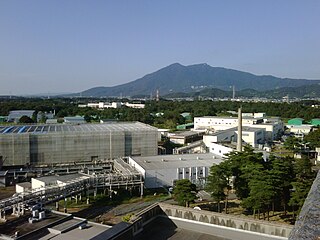
The High Energy Accelerator Research Organization, known as KEK, is a Japanese organization whose purpose is to operate the largest particle physics laboratory in Japan, situated in Tsukuba, Ibaraki prefecture. It was established in 1997. The term "KEK" is also used to refer to the laboratory itself, which employs approximately 695 employees. KEK's main function is to provide the particle accelerators and other infrastructure needed for high-energy physics, material science, structural biology, radiation science, computing science, nuclear transmutation and so on. Numerous experiments have been constructed at KEK by the internal and international collaborations that have made use of them. Makoto Kobayashi, emeritus professor at KEK, is known globally for his work on CP-violation, and was awarded the 2008 Nobel Prize in Physics.
A particle beam is a stream of charged or neutral particles. In particle accelerators, these particles can move with a velocity close to the speed of light. There is a difference between the creation and control of charged particle beams and neutral particle beams, as only the first type can be manipulated to a sufficient extent by devices based on electromagnetism. The manipulation and diagnostics of charged particle beams at high kinetic energies using particle accelerators are main topics of accelerator physics.
Plasma acceleration is a technique for accelerating charged particles, such as electrons or ions, using the electric field associated with electron plasma wave or other high-gradient plasma structures. These plasma acceleration structures are created using either ultra-short laser pulses or energetic particle beams that are matched to the plasma parameters. The technique offers a way to build affordable and compact particle accelerators.

The AWAKE facility at CERN is a proof-of-principle experiment, which investigates wakefield plasma acceleration using a proton bunch as a driver, a world-wide first. It aims to accelerate a low-energy witness bunch of electrons from 15 to 20 MeV to several GeV over a short distance by creating a high acceleration gradient of several GV/m. Particle accelerators currently in use, like CERN's LHC, use standard or superconductive RF-cavities for acceleration, but they are limited to an acceleration gradient in the order of 100 MV/m.

The Proton Synchrotron is a particle accelerator at CERN. It is CERN's first synchrotron, beginning its operation in 1959. For a brief period the PS was the world's highest energy particle accelerator. It has since served as a pre-accelerator for the Intersecting Storage Rings (ISR) and the Super Proton Synchrotron (SPS), and is currently part of the Large Hadron Collider (LHC) accelerator complex. In addition to protons, PS has accelerated alpha particles, oxygen and sulfur nuclei, electrons, positrons, and antiprotons.
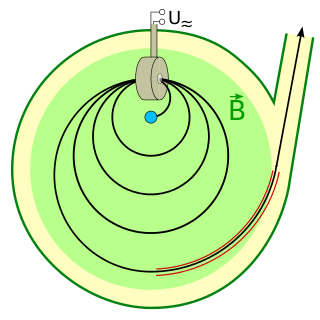
A microtron is a type of particle accelerator concept originating from the cyclotron in which the accelerating field is not applied through large D-shaped electrodes, but through a linear accelerator structure. The classic microtron was invented by Vladimir Veksler around 1944. The kinetic energy of the particles is increased by a constant amount per field change. Microtrons are designed to operate at constant field frequency and magnetic field in the ultrarelativistic limit. Thus they are especially suited for very light elementary particles, namely electrons.

A particle accelerator is a machine that uses electromagnetic fields to propel charged particles to very high speeds and energies, and to contain them in well-defined beams.
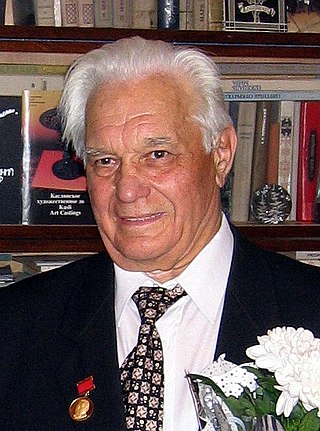
Vladimir Aleksandrovich Teplyakov was a Russian experimental physicist known for his work on particle accelerators. Together with I.M. Kapchinsky, he invented the principle of the radio-frequency quadrupole (RFQ), which revolutionized the acceleration of low-energy charged particle beams.

A radio-frequency quadrupole (RFQ) is a linear accelerator component generally used at low beam energies, roughly 2keV to 3MeV. It is similar in layout to a quadrupole mass analyser but its purpose is to accelerate a single-species beam rather than perform mass spectrometry on a multiple-species beam. As charged particles are accelerated along the beam line they alternately experience electric fields in two axes at right angles to the direction of motion, offset in phase, such that there is always a forwards force in the beam direction (Z), plus a beam focussing action alternately in X and then in Y. This is achieved by exciting 4 electrodes that run the length of the accelerator, and are shaped to have a periodically varying gap that matches the RF frequency to the beam velocity at that point in the accelerator. This causes the particles to form bunches in step with the exciting frequency, such that they pass through each region as the local field is near the acceleration maxima. There are two common electrode shapes, either a group of 4 vanes with a wave pattern on the tips that approach, or 4 cylinders with periodic conical sections. The electrodes are mounted in vacuum and excited from by suitably phased signals from a high power RF source. The advantages over a conventional RF LINAC with separated RF cavities and drift tubes are firstly that the beam is constantly accelerating so the design can be made considerably more compact for a given energy, and secondly the bunching and focussing of the beam.

The CERN Hadron Linacs are linear accelerators that accelerate beams of hadrons from a standstill to be used by the larger circular accelerators at the facility.
An energy recovery linac (ERL) is a type of linear particle accelerator that provides a beam of electrons used to produce x-rays by synchrotron radiation. First proposed in 1965 the idea gained interest since the early 2000s.

The Large Hadron Electron Collider (LHeC) is an accelerator study for a possible upgrade of the existing LHC storage ring - the currently highest energy proton accelerator operating at CERN in Geneva. By adding to the proton accelerator ring a new electron accelerator, the LHeC would enable the investigation of electron-proton and electron-ion collisions at unprecedented high energies and rate, much higher than had been possible at the electron-proton collider HERA at DESY at Hamburg, which terminated its operation in 2007. The LHeC has therefore a unique program of research, as on the substructure of the proton and nuclei or the physics of the newly discovered Higgs boson. It is an electron–ion collider, similar to the plans in the US and elsewhere, although the present design would not include polarized protons.

The LEP Pre-Injector (LPI) was the initial source that provided electrons and positrons to CERN's accelerator complex for the Large Electron–Positron Collider (LEP) from 1989 until 2000.


